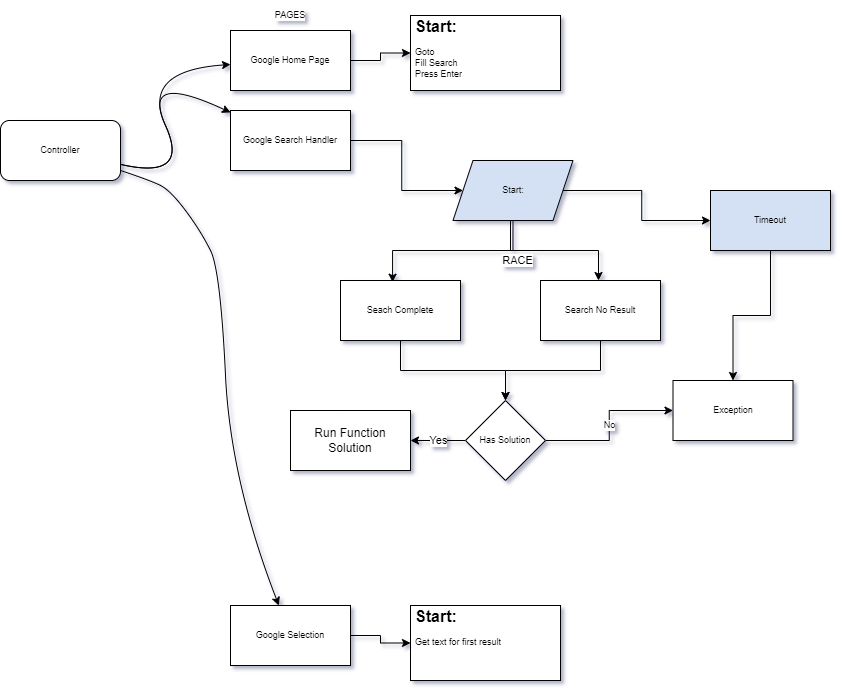- Libraries
- Dependencies
- Installing and Updating
- Start Project
- Variables Info
- Project Diagram
- Project Patterns
To install use this template project and clone repository,
remember to install all dependencies before starting this process.
bash ./start.bashFirst install dependencies with the following command
yarn installnow run the following command to start
yarn prod
# or
yarn debug| $i | $$s | $s |
|---|---|---|
| Instances Pages Object | All Selectors Instances | Current Page Selector |
The following example shows how it was implemented with google search
Page Object Model is a common pattern that introduces abstractions over web app pages to simplify interactions with them in multiple tests. It is best explained by an example.
now with some adaptations
-
Pages names must end with Page
import { PageContract } from "../../../@types/Page";
import BasePage from "../BasePage";
class GoogleSearchPage<PageType extends PageContract> extends BasePage<PageType> {
/**
* $s = current page selectors
*/
public readonly $s = this.$$s.GoogleSearchSelector;
/**
* the start method is used to start all steps referring to this page
*/
public async start(): Promise<this> {
await this.goto();
await this.fillSearch();
await this.pressEnter();
return this;
}
public async goto() {
return this.page.goto(this.$s.GOOGLE_HOME_URL);
}
public async fillSearch() {
const value = (Math.random() + 1).toString(36).substring(2, 18);
return this.page.type(this.$s.SEARCH_INPUT, value);
}
public async pressEnter() {
return this.page.keyboard.press("Enter");
}
}
export default GoogleSearchPage;- Only function calls are allowed
- Must always return current class
- Methods used by start must be public
- Methods must always return the result of the last executed promise
If you have any execution that is optional or your process cannot be terminated in case of error we strongly recommend the following pattern.
Dont use try/catch, .catch(() => {}) on start is more elegant and visible
public async start(): Promise<this> {
...
await this.clickAcceptCookie().catch(() => (/* Call log function if need */));
...
}Controller are responsible for defining the order that pages and handlers will be called.
Controllers names must end with Controller
import "colors";
import Instances from "../../@types/Instances";
import { PageContract } from "../../@types/Page";
import GoogleSelectionHandler from "../Handlers/Selection/GoogleSelectionHandler";
import initInstances from "../Pages/Pages";
class ExampleGoogleCrawlerController {
/**
* Current Page instance playwright/puppeteer
*/
public page: PageContract;
/**
* all instances are saved in this object.
*
* @NOTE: use it to avoid recursive import loop
*/
public $i: Instances<PageContract>;
/**
* You can create a baseController if you need to.
*/
constructor(page: PageContract) {
this.page = page;
this.$i = initInstances(this.page);
}
public async exampleSearch(): Promise<void> {
const GoogleSearch = await this.$i.GoogleSearchPage.start();
const HandlerSearch = new GoogleSelectionHandler<PageContract>(GoogleSearch);
await HandlerSearch.start();
const GoogleSelect = await this.$i.SearchSelectionPage.start();
console.log("Current Result:".bgCyan.black, GoogleSelect.firstElement);
}
}
export default ExampleGoogleCrawlerController;Selectors have some predetermined suffix rules, with them it is possible to understand selectors easily
Selectors names must end with Selector
/**
* By declaring the constant it is possible to retrieve the redis/database selectors if it is convenient for your project
*
* @NOTE: create the Types file right here if you need
*/
const GoogleSelectionEmptySelector = {
NOT_RESULT_ELEMENT: "#search div[role='heading']",
};
export default GoogleSelectionEmptySelector;Handlers are used when we need to make decisions, when an action can return more than 1 different result, a practical example would be the login can return (logged in, Incorrect password, Forbidden)
A simple example to show how we can use them properly
import { PageContract } from "../../../@types/Page";
import BaseHandler, { HandlerFunction, HandlerState } from "../BaseHandler";
class GoogleSelectionHandler<PageType extends PageContract> extends BaseHandler<PageType> {
public identifyHandler(): Promise<HandlerFunction> {
return Promise.race([this.identifyLoginCompleted(), this.identifyLoginForbidden(), this.identifyLoginFail()]);
}
public async defaultTimeout(): Promise<number> {
return 30000;
}
private async identifyLoginCompleted() {
return this.page
.waitForSelector(this.$$s.LoginSelector.LOGIN_COMPLETED_ELEMENT, { timeout: await this.defaultTimeout() })
.then(() => this.resolvedSolution.bind(this)); // resolvedSolution continue the process normally
}
private async identifyLoginForbidden() {
return this.page
.waitForSelector(this.$$s.LoginSelector.LOGIN_FORBIDDEN_ELEMENT, { timeout: await this.defaultTimeout() })
.then(() => this.forbiddenSolution.bind(this));
}
private async identifyLoginFail() {
return this.page
.waitForSelector(this.$$s.LoginSelector.LOGIN_FAIL_ELEMENT, { timeout: await this.defaultTimeout() })
.then(() => this.retryLoginSolution.bind(this));
}
private async forbiddenSolution() {
throw new Error("User Blocked");
}
/**
* When returning Verify in the handler it will be executed again to verify the new status, in this case as we re-try to log in we need to know what the new status is.
*/
private async retryLoginSolution() {
await this.page.goBack();
await this.$i.LoginPage.start();
return HandlerState.VERIFY;
}
public async start(): Promise<any> {
const solution = await this.identifyHandler();
return this.runSolution(solution);
}
}
export default GoogleSelectionHandler;- It should always contain a promise.race to identify which case it fell into
- Cases must return the function for Run Solution to execute
- functions with solutions must have the suffix Solution
- Promise.Race functions must have the identify prefix
- Define a number of attempts for your handler because if it has any HandlerState.VERIFY it will run in a loop until it falls into another condition
- Handler should be used to handle "Not Happy" cases






